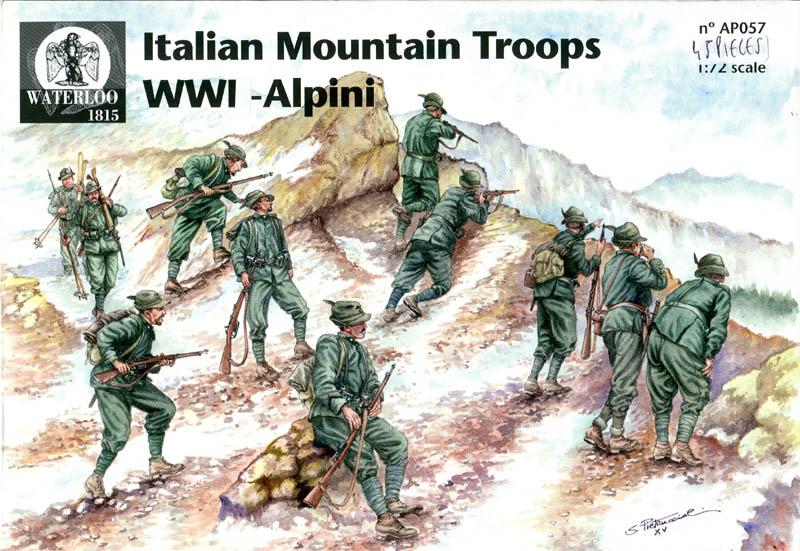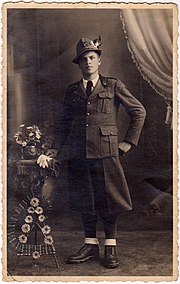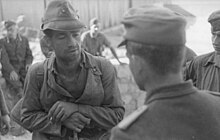
Terni M91 Carcano Semiauto Conversion
6m 45s
This rifle started out its life an a normal M91 Carcano long rifle, before being converted into an experimental self-loader by the Terni Arsenal. Rather than adding a gas piston to the barrel, Terni engineered a short recoil system. The barrel and bolt recoil together about a centimeter (3/8 inch) upon firing. Instead of the original bolt with two lugs and a 90-degree throw, a new 8-lug bolt was used, which only requires a slight amount of rotation to unlock. That unlocking is done by an angled wedge that the bolt travels up as it recoils rearward.
The rifle is still chambered in the original 6.5x52mm caliber, using standard 6-round Mannlicher style clips. The date of the conversion is not clear, although the base rifle was manufactured in 1908.

The Alpini are the Italian Army’s specialist mountain infantry. Part of the army’s infantry corps, the speciality distinguished itself in combat during World War I and World War II. Currently the active Alpini units are organized in two operational brigades, which are subordinate to the Alpine Troops Headquarters. The Alpini’s name comes from their inceptive association with the Alps, the mountain range that Italy shares with France, Switzerland, Austria, and Slovenia. An individual soldier of the Alpini is called an Alpino .



Thus Italy fielded the following six alpine divisions during World War II:
- 1st Alpine Division “Taurinense”
- 2nd Alpine Division “Tridentina”
- 3rd Alpine Division “Julia”
- 4th Alpine Division “Cuneense”
- 5th Alpine Division “Pusteria”
- 6th Alpine Division “Alpi Graie”
Alpino Della Mora Gelindo in WWII full dress uniform
Sergeant Giovannucci Verino in WWII battle uniform
Each division consisted of two Alpini regiments with three battalions each, one Alpine Artillery Regiment with three Artillery groups, one Mixed Engineer Battalion, one Logistic Battalion and some support units. The strength of each division was 573 officers and 16,887 NCOs and soldiers for a total strength of 17,460 men. Also each division had almost 5,000 mules and 500 vehicles of various types at its disposal.
The divisions saw combat in France, Africa, Italy, Albania, The Soviet Union, Yugoslavia and Greece. One Alpini battalion was employed in East Africa. In 1942, Tridentina, Julia and Cuneense division were sent to fight in the Soviet Union. In Russia, instead of being deployed in the Caucasus mountains as expected, the Alpini were tasked with holding a front on the plains of the Don River. As a result of this disastrous strategic decision, troops armed, trained, and equipped for mountain warfare were pitted in the plains against tanks and mechanized infantry, to counter which they were neither equipped nor trained. Despite this, the Alpini held the front until January 1943, when, due to the collapse of the Axis front, they were encircled by the advancing Soviet Army. The Alpini were able to break the encirclement in Battle of Nikolayevka and fight their way towards the new line of the front established after the Axis retreat. Only about one third of the Tridentina division (4250 survivors of 15,000 troops deployed) and one tenth of the Julia (1,200/15,000) were able to survive this odyssey. The Cuneense division was annihilated.
An Alpino speaks with a German officer during the campaign in Yugoslavia.
After the Armistice of Cassibile between the Kingdom of Italy and Western Allies became public on 8 September 1943, Italy split in half. The king went to the South of Italy and left the Royal Italian Army without any orders. Subsequently, most divisions of the Army surrendered without a fight to the invading German forces. The only Alpini division to resist the Germans was the 1st Alpine Division “Taurinense”, which along with the 19th Infantry Division “Venezia” and remnants of the 155th Infantry Division “Emilia” resisted German attempts to occupy Montenegro. After suffering heavy casualties the divisions troops were given the choice to either surrender or to retreat into the Durmitor mountains and continue the fight. The 16,000 men, who had chosen to fight, formed then the Italian Partisan Division Garibaldi, which entered the II Corps of the Yugoslav Partisans and fought on the Yugoslav Front until it returned to Italy in March 1945.
On June 25, 1944, the 3rd Alpini Regiment was recreated in Southern Italy with the battalions Piemonte and Monte Granero. Along with the 4th Bersaglieri Regiment it formed the 1st Italian Brigade of the Italian Liberation Corps, which fought in the war on the Allied side. After the Bersaglieri regiment had suffered heavy casualties the two regiments were merged on 30 September 1944 to form the Special Infantry Regiment, which entered the Legnano Combat Group. The Combat Group was equipped with British weapons and materiel and fought as part of the Polish II Corps on the extreme left of the British 8th Army near the river Idice.
In the north a fascist regime under dictator Benito Mussolini, known as the Republic of Salò continued the war alongside the Germans. Its Army, the fascist National Republican Army, raised the 4th Alpine Division “Monterosa”, which was trained and equipped by Nazi Germany.[11][12] The division fought along the Gothic Line, notably against units of Brazilian Expeditionary Division, U.S. 92nd Infantry Division and 8th Indian Infantry Division. At the end of the final allied offensive, the division surrendered after the Battle of Collecchio.[13]
See also: Fall of France; East African Campaign (World War II); Greco-Italian War; invasion of Yugoslavia; Italian war in Soviet Union, 1941-1943; Yugoslav People’s Liberation War; and Italian Campaign (World War II)
Beretta Model 1931 / 1937
Jump to navigationJump to search
Beretta Model 1931 - 6.5x52mm Carcano
Beretta Model 1937 - 7.35×51mm Carcano
The Beretta Mod. 31 is an Italian prototype self-loading rifle. Designed by Tullio Marengoni in 1931, the rifle was developed as a response to the Italian Army looking for a self-loading rifle. The rifle was redeveloped into the Beretta Model 1937 six years later due to the Army wanting to use 7.35×51mm Carcano instead as they felt that 6.5mm rounds lacked stopping power.
One rifle, serial number 1, is currently held in Beretta’s reference collection.
Specifications
Beretta Model 1931
(1931 - ???)
- Type: Battle Rifle
- **Caliber:**6.5×52mm Carcano
- Capacity: 6-round internal magazine
- Fire Modes: Semi-automatic
- Mass: 9 pounds (4.1 kilograms)
- Barrel length: 24.8 inches (63 centimetres)
Beretta Model 1937
(1937 - 1939)
Maefassi gas-operated conversion of the Mannlicher M.95(8x56mmR)

An Italian officer, Carlos Maefassi, designed this gas-operated, self-loading conversion of the Mannlicher M.95 rifle, while he was stationed in Ethiopia in the late 1930s. The conversion operates on a basic underbarreled gas piston with a long rack to allow the straight-pull bolt to reciprocate. A pistol grip was added to the stock. The Maefassi conversion was tested in about 1940 but never advanced beyond a prototype.
- Type: Battle Rifle
- Caliber: 7.35×51mm Carcano
- Capacity: 9-round internal box magazine
- Fire Modes: Semi-automatic
- Mass: 8.9 pounds (4.0 kilograms)
- Barrel length: 21 inches (53 centimetres)




